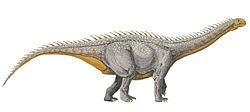| Blikanasaurus Temporal range: Late Triassic, | |
|---|---|
 | |
| Pes from the holotype of B. cromptoni | |
| Scientific classification | |
| Kingdom: | Animalia |
| Phylum: | Chordata |
| Class: | Reptilia |
| Clade: | Dinosauria |
| Clade: | Saurischia |
| Clade: | † Sauropodomorpha |
| Clade: | † Sauropoda |
| Family: | † Blikanasauridae Galton & van Heerden, 1985 |
| Genus: | † Blikanasaurus Galton & van Heerden, 1985 |
| Species: | †B. cromptoni |
| Binomial name | |
| †Blikanasaurus cromptoni Galton & van Heerden, 1985 | |
Blikanasaurus is a genus of sauropodomorph dinosaur from the late Triassic of South Africa. The generic name Blikanasaurus is derived from Greek, meaning "lizard from Blikana". The species name cromptoni is taken from the surname of A.W. "Fuzz" Crompton, an American paleontologist who led numerous field expeditions in Elliot Formation outcrop localities in South Africa. Blikanasaurus is only known from partial hindlimb bones that were recovered from the lower Elliot Formation (LEF) in the Eastern Cape. [1]











